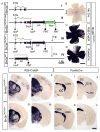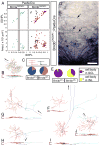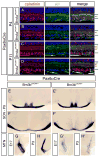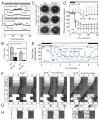Distinct roles of transcription factors brn3a and brn3b in controlling the development, morphology, and function of retinal ganglion cells
- PMID: 19323995
- PMCID: PMC2679215
- DOI: 10.1016/j.neuron.2009.01.020
Distinct roles of transcription factors brn3a and brn3b in controlling the development, morphology, and function of retinal ganglion cells
Abstract
Transcriptional regulatory networks that control the morphologic and functional diversity of mammalian neurons are still largely undefined. Here we dissect the roles of the highly homologous POU-domain transcription factors Brn3a and Brn3b in retinal ganglion cell (RGC) development and function using conditional Brn3a and Brn3b alleles that permit the visualization of individual wild-type or mutant cells. We show that Brn3a- and Brn3b-expressing RGCs exhibit overlapping but distinct dendritic stratifications and central projections. Deletion of Brn3a alters dendritic stratification and the ratio of monostratified:bistratified RGCs, with little or no change in central projections. In contrast, deletion of Brn3b leads to RGC transdifferentiation and loss, axon defects in the eye and brain, and defects in central projections that differentially compromise a variety of visually driven behaviors. These findings reveal distinct roles for Brn3a and Brn3b in programming RGC diversity, and they illustrate the broad utility of germline methods for genetically manipulating and visualizing individual identified mammalian neurons.
Figures







Similar articles
-
Genetic interactions between Brn3 transcription factors in retinal ganglion cell type specification.PLoS One. 2013 Oct 8;8(10):e76347. doi: 10.1371/journal.pone.0076347. eCollection 2013. PLoS One. 2013. PMID: 24116103 Free PMC article.
-
Morphologies of mouse retinal ganglion cells expressing transcription factors Brn3a, Brn3b, and Brn3c: analysis of wild type and mutant cells using genetically-directed sparse labeling.Vision Res. 2011 Jan 28;51(2):269-79. doi: 10.1016/j.visres.2010.08.039. Epub 2010 Sep 6. Vision Res. 2011. PMID: 20826176 Free PMC article.
-
Brn3b/Brn3c double knockout mice reveal an unsuspected role for Brn3c in retinal ganglion cell axon outgrowth.Development. 2002 Jan;129(2):467-77. doi: 10.1242/dev.129.2.467. Development. 2002. PMID: 11807038
-
A comprehensive negative regulatory program controlled by Brn3b to ensure ganglion cell specification from multipotential retinal precursors.J Neurosci. 2008 Mar 26;28(13):3392-403. doi: 10.1523/JNEUROSCI.0043-08.2008. J Neurosci. 2008. PMID: 18367606 Free PMC article.
-
Regulation of Brn3b by DLX1 and DLX2 is required for retinal ganglion cell differentiation in the vertebrate retina.Development. 2017 May 1;144(9):1698-1711. doi: 10.1242/dev.142042. Epub 2017 Mar 29. Development. 2017. PMID: 28356311 Free PMC article.
Cited by
-
Atoh7-independent specification of retinal ganglion cell identity.Sci Adv. 2021 Mar 12;7(11):eabe4983. doi: 10.1126/sciadv.abe4983. Print 2021 Mar. Sci Adv. 2021. PMID: 33712461 Free PMC article.
-
Genetic control of retinal ganglion cell genesis.Cell Mol Life Sci. 2021 May;78(9):4417-4433. doi: 10.1007/s00018-021-03814-w. Epub 2021 Mar 29. Cell Mol Life Sci. 2021. PMID: 33782712 Free PMC article. Review.
-
Loss of AP-2delta reduces retinal ganglion cell numbers and axonal projections to the superior colliculus.Mol Brain. 2016 Jun 4;9(1):62. doi: 10.1186/s13041-016-0244-0. Mol Brain. 2016. PMID: 27259519 Free PMC article.
-
A Novel Reporter Mouse Uncovers Endogenous Brn3b Expression.Int J Mol Sci. 2019 Jun 14;20(12):2903. doi: 10.3390/ijms20122903. Int J Mol Sci. 2019. PMID: 31197108 Free PMC article.
-
Molecular mechanisms regulating synaptic specificity and retinal circuit formation.Wiley Interdiscip Rev Dev Biol. 2021 Jan;10(1):e379. doi: 10.1002/wdev.379. Epub 2020 Apr 8. Wiley Interdiscip Rev Dev Biol. 2021. PMID: 32267095 Free PMC article. Review.
References
-
- Badea TC, Nathans J. Quantitative analysis of neuronal morphologies in the mouse retina visualized by using a genetically directed reporter. J Comp Neurol. 2004;480:331–351. - PubMed
-
- Bodnarenko SR, Chalupa LM. Stratification of ON and OFF ganglion cell dendrites depends on glutamate-mediated afferent activity in the developing retina. Nature. 1993;364:144–146. - PubMed
Publication types
MeSH terms
Substances
Grants and funding
LinkOut - more resources
Full Text Sources
Other Literature Sources
Molecular Biology Databases

